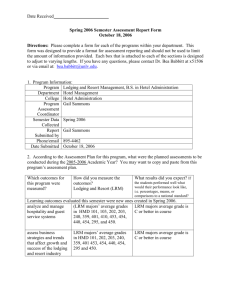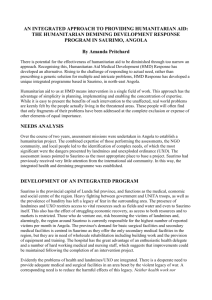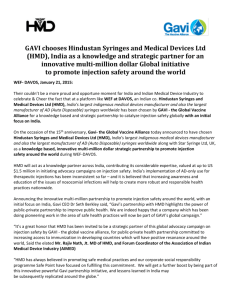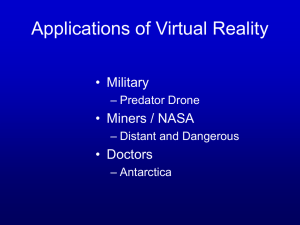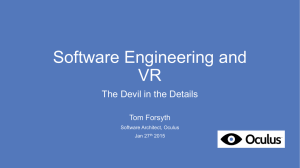Annual Assessment Report Form for Student Learning Outcomes
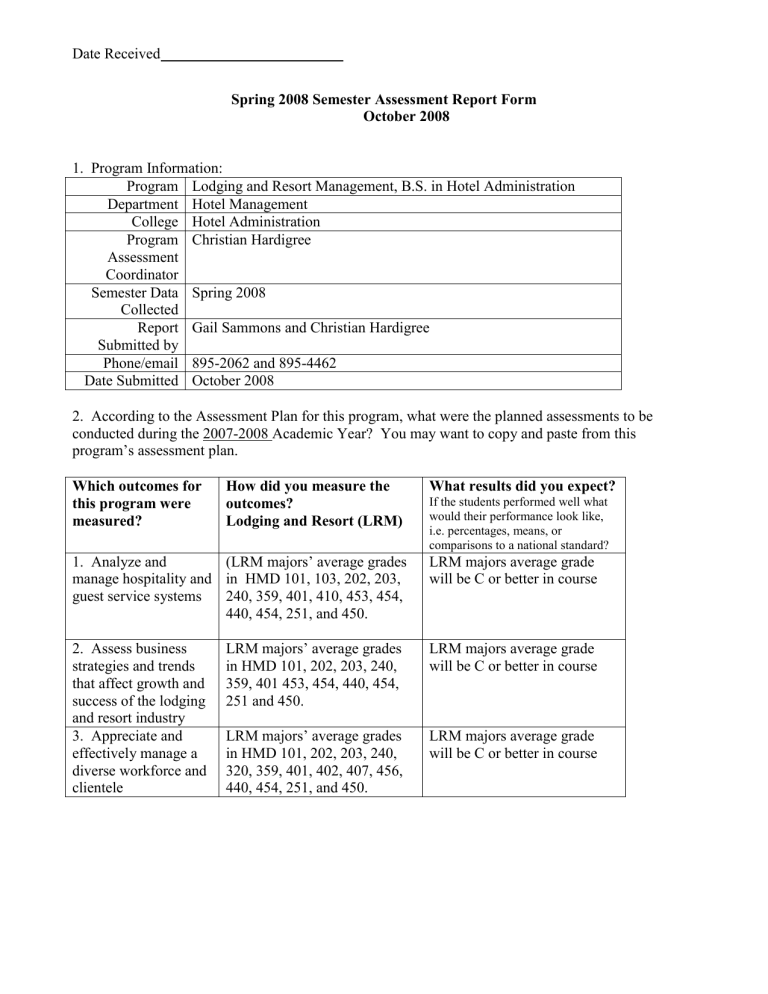
Date Received
Spring 2008 Semester Assessment Report Form
October 2008
1. Program Information:
Program Lodging and Resort Management, B.S. in Hotel Administration
Department Hotel Management
College Hotel Administration
Christian Hardigree Program
Assessment
Coordinator
Semester Data
Collected
Spring 2008
Report
Submitted by
Gail Sammons and Christian Hardigree
Phone/email 895-2062 and 895-4462
Date Submitted October 2008
2. According to the Assessment Plan for this program, what were the planned assessments to be conducted during the 2007-2008 Academic Year? You may want to copy and paste from this program’s assessment plan.
Which outcomes for this program were measured?
1. Analyze and manage hospitality and guest service systems
2. Assess business strategies and trends that affect growth and success of the lodging and resort industry
How did you measure the outcomes?
Lodging and Resort (LRM)
(LRM majors’ average grades in HMD 101, 103, 202, 203,
240, 359, 401, 410, 453, 454,
440, 454, 251, and 450.
LRM majors’ average grades in HMD 101, 202, 203, 240,
359, 401 453, 454, 440, 454,
251 and 450.
What results did you expect?
If the students performed well what would their performance look like, i.e. percentages, means, or comparisons to a national standard?
LRM majors average grade will be C or better in course
LRM majors average grade will be C or better in course
3. Appreciate and effectively manage a diverse workforce and clientele
LRM majors’ average grades in HMD 101, 202, 203, 240,
320, 359, 401, 402, 407, 456,
440, 454, 251, and 450.
LRM majors average grade will be C or better in course
Which outcomes for this program were measured?
How did you measure the outcomes?
Lodging and Resort (LRM)
4. Evaluate the management and design of lodging and resort facilities systems including safety, security, water,
HVAC, and energy management
5. Analyze, design, and evaluate effective workplace performance systems including training, development, performance appraisal and compensation
6. Collect, evaluate, synthesize, and apply information and research to make sound managerial decisions
7. Communicate clearly orally and in writing with recruiters, management, guests, and co-workers
8. Demonstrate a high degree of ethics and professionalism
LRM majors’ average grades in HMD 101, 395, 410, 440,
454, 251, and 450.
LRM majors’ average grades in HMD 359, 402, 456, 440,
454, 251, and 450.
LRM majors’ average grades in HMD 101, 359, 401, 402,
407, 202, 203, 240, 410, 440,
454, 251, and 450.
LRM majors’ average grades in HMD 101, 359, 401, 402,
407, 202, 203, 240, 410, 440,
454, 251, and 450.
Alumni Reputation
LRM majors’ average grades in HMD 101, 359, 401, 402,
407, 453, 456, 440, 454, 251, and 450.
Alumni Reputation
What results did you expect?
If the students performed well what would their performance look like, i.e. percentages, means, or comparisons to a national standard?
LRM majors average grade will be C or better in course
LRM majors average grade will be C or better in course
LRM majors average grade will be C or better in course
LRM majors average grade will be C or better in course
LRM majors average grade will be C or better in course
3.
Results, conclusions, and discoveries. What are the results of the planned assessments listed above? What conclusions or discoveries were made from these results? Describe below or attach to the form.
Results, conclusions, and discoveries
In the following HMD courses offered Spring 2008 LRM majors earned average grades of:
HMD 101 4.0 HMD 202 Fall only HMD 203 2.7
HMD 103 3.0 HMD 240 3.9 HMD 340 not offered
HMD 259 3.5 HMD 320 4.0
HMD 395 3.0 HMD 410 2.5 HMD 450 no majors spring
HMD 401 2.8 HMD 453 3.7
HMD 402 2.9 HMD 454 2.0 HMD 450 3.0
HMD 407 2.8 HMD 456 3.6 HMD 440 not offered
Head counts continue to increase in the Lodging & Resorts Management Major.
Student Headcount by Major,
Student College
Major College
Spring
2005
Spring
2006
Spring
2007
Spring
2008
LODGING AND RESORT
MANAGEMENT HOA
5
20 50 64
Rating scale if a 4 point scale
HMD 101
HMD
101
HMD
101
This course increased my understanding of the subject matter.
Course assessments covered the key concepts of the course
Course materials helped clarify the subject matter
3.8
3.5
3.6
3.2
3.1
3
3.6
3.7
3.6
HMD
101
3.1
3.4
3.3
HMD
103
HMD
103
HMD
103
HMD
103
HMD
103
This course increased my understanding of the subject matter.
Course assessments covered the key concepts of the course
2.9
3
2.9
3
3.3
3.1
2.4 2.6
2.5 2.8
Course materials helped clarify the subject matter 3.1 3 3.2 2.5 2.6
This course increased my understanding of the subject matter.
Course assessments covered the key concepts of the course
Course materials helped clarify the subject matter
HMD 376
3.8
3.6
3.5
HMD
395
3.2
3.2
3.1
HMD
395
3.5
3.2
3.1
HMD
395
3.4
3.1
3
HMD
395
3.5
3.7
3.6
HMD
395
3.3
3.4
3.3
This course increased my understanding of the subject matter.
Course assessments covered the key concepts of the course
Course materials helped clarify the subject matter
HMD 401
3.4
3.4
3.5
HMD
401
3.3
3.2
3.1
HMD
401
3.8
3.7
3.7
HMD
401
3.4
3.2
3.1
This course increased my understanding of the subject matter.
Course assessments covered the key concepts of the course
Course materials helped clarify the subject matter
HMD
407
HMD
407
This course increased my understanding of the subject matter.
Course assessments covered the key concepts of the course
Course materials helped clarify the subject matter
2.9
2.5
2.7
HMD
402
2.9
2.5
2.7
3.7 3.7 2.7
3.8 3.7
3.8 3.7 2.8
HMD
407
HMD
402
3.7
3.6
3.4
HMD
402
HMD
407
3
1.7
2.3
2.3
HMD
401
HMD
402
3.4
2.9
3.1
HMD
407
3.8
3.6
3.6
3.8
3.8
3.9
HMD
401
HMD
410
3.3
2.7
2.7
HMD 402
1.7
1.4
1.2
3.8
3.8
3.7
This course increased my understanding of the subject matter.
Course assessments covered the key concepts of the course
Course materials helped clarify the subject matter
HMD
453
3.3
3.3
3.2
HMD
453
HMD 454
1.8
2.1
2.2
HMD
454
This course increased my understanding of the subject matter.
Course assessments covered the key concepts of the course
Course materials helped clarify the subject matter
3.5
3.3
3.1
2.9
2.7
2.7
HMD
453
3.7
3.8
3.7
HMD
454
3
2.9
2.7
HMD
453
3.4
3.7
3.3
HMD
454
3.4
3.4
3.3
HMD
453
3.3
3.3
2.9
HMD
454
3.8
3.5
3.5
LRM Survey
N Mean
Std.
Dev.
HMD
456
3.7
3.9
3.6
Q1. Appreciate a diverse workforce
Q2. Appreciate a diverse clientele
Q3. Effectively manage a diverse workforce
113 3.34
113 3.32
112 3.29
0.74
0.78
0.76
Q4. Effectively manage a diverse clientele. 112 3.24
Q5. Evaluate the management of lodging and resort facilities safety systems. 113 3.10
Q6. Evaluate the design of lodging and resort facilities safety systems 113 3.03
Q7. Evaluate the management and design of lodging and resort facilities secutity systems 111 2.87
Q8. Evaluate the management and design of lodging and resort facilities water, HVAC, and energy management systems 113 2.99
0.92
0.95
0.75
0.81
0.86
LRM Survey
N Mean
Std.
Dev.
Q9. Analyze effective workplace training and development systems.
Q10. Design effective workplace training and development systems.
Q11. Analyze effective workplace performance appraisal systems.
Q12. Design effective workplace performance appraisal systems.
Q13. Evaluate effective workplace performance appraisal systems.
Q14. Analyze effective workplace compensation systems.
Q15. Design effective workplace compensation systems.
Q16. Evaluate effective workplace compensation systems.
Q17. Collect and evaluate information to make sound managerial decisions
Q18. Synthesise and apply information to make sound managerial decisions
Q19. Communicate clearly in writing with recruiters.
Q20. Communicate clearly in writing with management.
Q21. Communicate clearly in writing with guests.
Q22. Communicate clearly in writing with coworkers.
Q23. Communicate clearly orally with recruiters.
Q24. Communicate clearly orally with management.
113 3.20
113 3.17
113 3.13
113 2.96
113 3.00
113 2.88
113 2.89
113 2.95
113 3.35
112 3.25
113 3.10
113 3.19
113 3.24
113 3.18
113 3.25
113 3.32
Q25. Communicate clearly orally with guests. 113 3.34
Q26. Communicate clearly orally with coworkers. 113 3.32
Q27. Demonstrate a high degree of ethics.
Q28. Demonstrate a high degree of professionalism.
Q29. Aquiring job or work related knowledge and skills.
Q30. Writing clearly and effectively.
Q31. Thinking clearly and effectively.
Q32. Analyzing quantitative problems.
113 3.32
112 3.40
112 3.40
112 3.31
112 3.33
112 3.20
0.91
0.73
0.74
0.89
0.84
0.78
0.87
0.75
0.74
0.80
0.87
0.82
0.89
0.89
0.76
0.75
0.70
0.75
0.79
0.75
0.73
0.74
0.70
0.75
LRM Survey
Q33. Using computing and information technology.
Q34. Working effectively with others.
Q35. Understanding people of other racial and ethinic backgrounds.
N Mean
112 3.14
112 3.46
112 3.36
Std.
Dev.
0.86
0.77
0.78
Q36. Solving complex real-world problems
Q37. Develop or refine personal code of values and ethics
112 3.25
108 3.25
0.84
0.78
Q38. Overall, how would you rate your entire educational experience at UNLV? 106 3.11 0.71
HMD 101: The goal is to familiarize students with the hospitality and tourism industry by teaching; composition and structure of entities, type of career positions, vocabulary, and basic operating procedure, so that they can begin to think about a major, as well as a career path.
Students are required to complete a practical industry-related community service project, and speakers are invited to the class to talk about contemporary practices. To measure learning outcome and knowledge acquired, a pre/post test is given as well as quizzes and a final examination. The aggregate avg. pre-test score was 52% correct answers whereas the post-test reflected 75% correct answers. Thus, a variance of + 23% is indicative of the teaching/learning outcome. At a glance, it is important to note the difference in student grades (avg gpa), and faculty evaluation scores for the fall class with an enrollment of 130 students taught in a large lecture hall (BEH 241), and the spring class with an enrollment of 49 taught in BEH 122. Both measures (student gpa and faculty evaluations) indicate that smaller classes are more conducive to teaching/learning than large ones. The large lecture hall environment tends to have an adverse effect on motivation and goal attainment for the faculty as well as the students. I cannot ascertain the learning outcome for Valley High Students as no pre/post test was used, and the teacher developed his own assessments. For articulation reasons, the goal is to change this in the future so that the course structure, content, and learning outcome measures are in line with the UNLV sections.
HMD 101 Best Essays Spring 2008 – HMD 101 Taught by Carl Braunlich
The number of oral interactions with students increased 35% over the first three week period of the semester compared with the final three week period of the semester. The quality of the interactions improved continuously during the semester, as the problem analysis during class, questions posed to guest presenters, and interactions with the instructor showed dramatic improvement during the course of the term. Essay grades improved over 26% from the beginning of the semester as the students became more proficient in writing concise essays with clarity of thought.
HMD 103
HMD 103-4 & HMD 103-6
To begin with, this report is based on pre- and post tests administered in my undergraduate courses. The pre-test does not impact the grade of the student and is administered before instruction begins. It is a comprehensive exam covering all of the learning modules in the course. The post-test, also a comprehensive exam, is almost identical to the pre-test and serves as the students’ final exam in the course. Not every student takes the pre-test because of the late enrollment opportunity afforded to our students. Since the exam is administered on the first day of class, some students are not present until the second week of classes.
Here are the class averages for the HMD 103-4 Lodging Introduction course:
Pre-
Test
Average
Post-
Test
Average
Raw
Score
Increase
55.1% 75.0% 19.9
Points
26.53%
The percentage increase in HMD 103-4 of approximately 26% from the pre-test to the final exam is typical performance. Final scores in section four were 72.06%. The final score also reflects a few students who stopped attending, but who chose to remain in the course. The average in the course without those students would, in my estimation be around 76%, a fairly respectable course average.
Here are the class averages for the HMD 103-6 Lodging Introduction
Pre-
Test
Average
Post-
Test
Average
Raw
Score
Increase
Percentage
Increase from Pre-
Test to
Post-Test
Percentage
Increase from Pre-
Test to
Post-Test
54.0% 74.8% 20.8
Points
27.80%
The percentage increase in HMD 103-4 of approximately 28% from the pre-test to the final exam is typical performance. Final scores in section four were 72.97%. The final score also reflects a couple of students who stopped attending, but who chose to remain in the course. The average in the course without those students would, in my estimation be around 77%, a fairly respectable course average.
I provided instructional objectives for each chapter, and it was from those objectives that the test questions were based. My instruction in the course focused on those objectives. The course had several guest speakers and after every guest speaker, instructional objectives that related to potential test questions were posted for the students. The student cohort that did the worst in the class was Asian, and at the same time, some of the better students were also Asian. The ones that
did not do well seem to exhibit certain common traits, the chief one being an abject command of the English language. As long as this university allows people to enroll who lack the basic skills, this will continue to be a problem
HMD 103
SPRING 2008 Section 001
PRE-TEST/POST-TEST RESULTS (Total Points = 50)
(# of students) survey 54 students
Pre-Test class average
20.7 out of 50
Post-Test class average
32.8 out of 50
(12.1 / 50 questions) = 24.2 % improvement
HMD 103
SPRING 2008 Section 002
PRE-TEST/POST-TEST RESULTS (Total Points = 50)
(# of students) Pre-Test class average
Post-Test class average survey 55 students
20.7 out of 50 35.0 out of 50
(14.3 / 50 questions) = 28.6 % improvement
HMD 251
HMD 251: Each Student most work 200+ in hours, in a lodging facility, during the semester in which he/she is registered for the course. The goal is to encourage students who are working in hotel departments to learn more practical things about work methods, management responsibilities, organizational structure, interdepartmental relations and guest services. Since most employees report to work, perform the taskS they are hired to perform, and go home when their shift ends, they do not learn much about management duties and how their work relates to the overall mission. In HMD 251, this is accomplished by having students submit two assignments. The first one requires each student to conduct questionnaire/interview job analysis (JA) with managers. Subsequently he/she must write a job description (JD) for the incumbent interviewed. The second assignment is a ten-page paper describing the students’ job duties, incidents, problems solved, cash handling procedures (if applicable), guest and employee relations practices, guest confidentiality procedures, lost and found, risk management policies, and other specifically assigned operational challenges for managers.
Learning outcome is measured by the content of both assignments. During the two semesters covered by this assessment, 96% of the student (68 out of 71), pass the course, whereas 4% (3) failed to do the assignments.
HMD 450
HMD 450: The goal is to expose students to the major functional departments of a hotel by scheduling them to rotate through these departments. Basically, this rotation consists of shadowing, documenting procedures, asking questions, and providing assistance on a limited basis. Since this experiential arrangement qualifies as a nonpaid internship, students do not perform the duties of an incumbent or would-be job holder. To do so may violate FLSA, or union rules. Related to this rotational observation and documentation schedule, each student must complete three hotel related assessments, respond to
10 videos related to hotel operations, read some assigned articles, read a book (“From Good to Great” by Collins), complete two assignments (a leadership assessment assignment and a departmental SWOT analysis), and prepare an operational portfolio consisting of departmental journal notes, organizational charts with management overall responsibilities, mission statements, sample resume and cover letter,
“thank you” letters, and an internship value statement. Very few students take this course due to the rigor entailed and the difficulty of getting hotels to structure and supervise the on-site rotational program. However, the comment I generally get from those who take it is, ”I learned more about hotel operations from this course than any course I have taken in the hotel college!” The statement is generally made
after the grade has been submitted.
HMD 376 & 395
Evaluate the management and design of lodging and resort facilities systems.
The following information is being provided as a general assessment report for the Facilities Management and
Design (HMD-395) and the Green Hospitality and Sustainable Business Practices (HMD-376E) courses.
Lodging and Resorts Management Learning Assessment Indicators:
Semester: Spring 2008
Course # Average Grade # of Students Pre/Post Grade % Improvement
Instructors Evaluation Rating
HMD-376E B+ 15 32.0
HMD-395.2 B 44 35.7
HMD-395.3 B- 23 49.8
_________________________________________________________________________________________
_____________________________
Totals Av. B 82 39.2
!.) All students were administered a pre-course assessment exam consisting of 100 questions prior to the beginning of any classroom instruction.
2.) All students completed a post-course exam at the end of the semester, and the questions were the same as the those completed at the beginning of the course on the pre-course exam.
3.) All students enrolled in the HMD-395 course were required to complete a Life-Safety Project that was conducted at the CCSN Sahara Ave. location. The training included: CPR: AED; and Heimlich Choking.
Students were required to earn certification on a pass/fail basis, and to also prepare a project paper indicating what they learned through this Life-Safety Project that would enhance their service delivery contributions to their future hospitality customers. Students successfully completing the Life-Safety Project earned a "Heart-
Saver" certification that can be used to demonstrate their competency as individuals qualified to conduct lifesaving techniques for the public at large.
4.) Students enrolled in my Green Hospitality and Sustainable Business Practices (HMD-376E) course also had a project requirement. Three seperate group projects were offered for each of the students to select a project of choice. Each student's contribution to the larger scope of the project was evaluated on the basis of their project contribution to the goals as established by their group. At the end of the Spring semester, each group presented their "group project" to the other members of the HMD-376E class.
5.) Hard-copies of the individual and group projects are available upon request.
HMD 401: Pre test/ Post test
Avg Improve 0.32
PT
# /56 %
1 19 0.34
2 17 0.30
3 27 0.48
4 10 0.18
/60 % /58 %
48 0.80
44 0.73
23 0.38
5 19 0.34
6 37 0.66
7 7 0.12
8 42 0.75
9 16 0.28
11 40 0.71
12 52 0.93
15 39 0.69
16 16 0.28
17 30 0.53
18 10 0.18
19 5 0.09
21 19 0.34
22 11 0.20
24 37 0.66
40 0.67
57 0.95
31 0.52
46 0.77
44 0.73
36 0.62
48 0.83
/57 %
46 0.81
35
47
52
0.61
0.82
0.91
57 0.98
51 0.88
54 0.95
46 0.81
28 0.49
36 0.63
Improve
0.46
0.43
-0.10
0.63
0.27
-0.04
0.54
0.20
0.54
0.11
-0.02
0.25
0.27
0.80
0.40
0.43
0.54
0.22
25 19 0.34
Avg 0.42
Assessment Spring 2008
HMD 401.003
0.70
32 0.55
0.77 0.75
0.21
Assessment Method:
Students complete a 50-question true/false exam on the first day of class. The questions test their basic knowledge of fundamental legal principles covered throughout the course.
At the conclusion of the semester, I administered the same 50-question exam.
Pre-semester test Score: 52 tests, average score 14 correct out of 50 (28% correct)
Low – 0 correct
High – 22 correct
Post-semester test Score: 40 tests, average score 38 correct out of 50 (76% correct)
Low – 28 correct
High – 47 correct
Average improvement of 48% for the class.
Grade distribution: 48 students enrolled at final exam. Average GPA 71.2
5 students did not take the final exam. Average GPA without those students 79.5
HMD 402
Outcome assessment this semester is based on the results of pretests/posttests for all sections. In the HMD 402, Employment Law, classes the assessment instrument consisted of 18 objectivestyle questions that I considered key learning points Pretests and posttest rankings were then compared to determine transfer of knowledge, assessment.
M/W Sect. M/W Sect. T/Th Sect. T/Th Sect.
PRETEST POSTTEST PRETEST POSTTEST
Number of
Incorrect
Responses
(59 tested)
Number of
Incorrect
Responses
Number of
Incorrect
Responses
Number of
Incorrect
Responses
(48 tested) (43 tested) (43 tested)
13
14
15
16
9
10
11
12
17
18
5
6
7
8
1
2
3
4
7
9
17
21
19
32
19
45
46
10
38
22
29
40
39
45
23
8
4
26
14
1
4
5
12
15
12
19
7
4
12
6
25
30
31
36
31
9
29
20
19
18
13
32
10
14
7
17
20
46
7
20
28
26
15
19
High Grade High Grade High Grade High Grade
14 18 13 18
Low Grade Low Grade Low Grade Low Grade
9
12
11
9
14
17
10
21
23
2
5
7
29
15
13
31
Ave = 8.8
4 10
Ave = 13.8 Ave = 8.8
3
Ave = 11.9
6
7
Comments/Observations
HMD 402
With a couple of exceptions, students demonstrated transfer of knowledge when pretests are compared to posttests. In some instances, the increase is dramatic e.g. Questions 2, 3, 7, 8, 12, and 18 especially. The average grade in both sections increased and it is noted that on the posttest, 3 students earned a perfect score. The lowest grade in both sections exceeded the lowest grade when compared to the pretest.
The pretests and posttests had no effect on student grades i.e. was not computed into their actual scores or used for extra credit. This summer, as an experiment, I will announce that the use the results of the posttest will be used for extra credit and see if this impacts retention of information/transfer of knowledge.
HMD 407
The pre-test resulted in 85 students averaging 43.4% on the 50 question multiple-choice test.
The post-test resulted in 79 students averaging 69.4% on the same 50 question multiple-choice test.
While pleased to see what I'm reasonably sure is a statistically significant shift in the mean score of the posttest, the absolute percentage after a semester's instruction is disappointing. Several students scored over 80%, high score was 90%, but the standard deviation was large with several students scoring much lower. Retention appears to be an issue with several students.
HMD 454
The primary objective of this course is to provide the advanced-standing hospitality management student with an understanding of the strategic-management process and how that process applies to firms or organizations in the hospitality industry or other relevant fields. Rapid changes in society and the impacts of these changes on the hospitality industry mandate ongoing future-oriented processes for managing organizations and their environments. Such a process requires the utilization of knowledge and experience derived from many disciplines if firms are to survive and remain profitable.
A second objective of this course is to provide the student with an opportunity to apply specific subject matter learned in prerequisite courses to business problems and issues raised in the strategic-management business policy case study that comprises a large part of this course. Management (consulting) teams will be evaluated, in part, on their ability to accurately assess project requirements, to develop criteria for this assessment, document their decisions, and effectively present this information.
Other objectives of this course include:
1. To increase understanding of what managers must do to make hospitality businesses succeed over the long run;
2. To develop the capacity to identify strategic issues and to reason carefully about strategic options;
4. To build skills in conducting strategic analysis in the hospitality industry and various competitive situations;
5. To extend the ability to formulate, articulate, and defend a strategic plan;
6.
To learn how to work with others on specific projects; and
7.
To enhance presentation skills.
Examples of student work assessing the following objectives:
1.
To increase understanding of what managers must do to make hospitality businesses succeed over the long run;
2.
To develop the capacity to identify strategic issues and to reason carefully about strategic options;
3.
To build skills in conducting strategic analysis in the hospitality industry and various competitive situations;
4.
To learn how to work with others on specific projects
See P.F. Chang’s and Morton’s available in HMD department files
Examples of student work assessing the following objectives:
5.
To extend the ability to formulate, articulate, and defend a strategic plan;
6.
To learn how to work with others on specific projects;
7.
To enhance presentation skills.
See Starwood Presentation
Objectives measured in HMD 454 (sections 3 and 4):
Objectives 2, 6, and 7 (out of the 8 listed in our LRM objectives outline) were directly assessed via the following two evaluation items:
1.
Individual case studies – each student was required to make an oral presentation about a lodging industry related case study. The student was asked to fully utilize the six steps for Case
Preparation Framework to analyze the assigned case and provide a detailed strategic action plan. The presentation was carried out in an executive meeting format where the student was required to dress professionally, hand-in professional reports documenting the case study and use A/V equipment to describe/defend the proposed strategic action plan.
A rubric was utilized to grade the activity. (see the attached pdf file entitled ‘HMD 454 case study presentation grading criteria’). In addition to the instructor, the presenters were also evaluated by other members of the class (see page #2). A sample case study analysis is attached
(ppt file).
2.
Industry Project – students worked in teams of 4 or 5 to address actual industry problems. Each student team was assigned a company to study and analyze. For example, Project City Center by MGM/Mirage.
Students were encouraged to contact the assigned company to gather information. The student team was asked to provide an executive report upon using strategic analysis methods (described in Fred David’s textbook) to address the issues faced by the assigned organization. The findings were also presented to class. A sample of the completed project and presentation slides are attached as separate files in the e-mail. A rubric was utilized to grade these activities. (see page #3)
PRESENTER(S) & TOPIC _______________________________________________
(Please write your full name -at the top right corner- on the BACK of this form). You MUST justify your grading with your comments in order to earn points towards participation.
Criteria:
Excellent Poor Creativity
Innovative, imaginative, surprising
5 4 3 2 1
Comment:
Communication
Clear, well presented
Comment:
Excellent
5 4 3 2
Poor
1
Technical Content
Relevant to the topic, use of theory
Comment:
Excellent
5 4 3 2
Poor
1
Excellent Poor Audience
Management
Quality of discussion, questions
Comment:
5 4 3 2 1
HMD Industry Project Guidelines & Criteria
PROJECT DESCRIPTION –Using the strategic management process and principles described in the textbook, teams of students will analyze a hospitality organization (assigned by the instructor) and develop an executive report that includes an explicit and competitive action plan. In addition to the report, the findings will be presented and shared in class. The project is 25% of the total course grade. Please note that there are three student teams assigned to each organization. The best team project out of three may qualify for the total available 100 pts. The remaining projects may be assigned a maximum of 95/100 pts.
PHASE 1 (10 pts.)
Step 1: Identify the assigned firms’ existing vision, mission, objectives, and strategies.
Step 2: Develop vision and mission statements for the organization.
PHASE 2 (30 pts.)
Step 3: Identify the organization’s external opportunities and threats.
Step 4: Construct a Competitive Profile Matrix (CPM).
Step 5: Construct an External Factor Evaluation (EFE) Matrix.
Step 6: Identify the organizations’ internal strength’s and weaknesses.
Step 7: Construct an Internal Factor Evaluation (IFE) Matrix.
PHASE 3 (25 pts.)
Step 8: Prepare a Strengths-Weaknesses-Opportunities-Threats (SWOT) Matrix. Where appropriate, consider including any or all of the following tools: Strategic Position and Action Evaluation (SPACE) Matrix, Boston Consulting Group
Matrix, Internal-External (IE) Matrix, Grand Strategy Matrix, and Quantitative Strategic Planning Matrix (QSPM).
PHASE 4 (30 pts.)
Step 9: Recommend specific strategies and long-tern objectives. Show how much your recommendations will cost.
Clearly itemize these costs for each projected year.
Step 10: The Benchmark Approach: Specify how your recommendations can be implemented and what results you can expect. Present a timetable or agenda for actions. Recommend procedures for strategy review and evaluation.
CONTENT REQUIREMENTS / EXPECTATIONS/ ITEMS TO BE SUBMITTED
1.
Upon successful completion of the four phases, the findings must be compiled and presented as an ‘Executive Report’
(Format: 1” margins, single-spaced, 12 font Times New Roman, page numbers aligned to the right). All sources used must be cited using APA style.
2.
Please include cover page (with title of the project and team members’ names), table of contents, executive summary, and references list.
3.
Submit an electronic copy of the report on or before the due date (via WebCampus).
4.
In addition to the written report, a presentation file of the project (in MS PowerPoint) must be submitted via
WebCampus in order to receive a grade for the project. All teams must be prepared to give a 10-15 minute professional business presentation - to be held as indicated on the class schedule. Please note that the presentation standards for individual case presentations will apply.
5.
The report and the presentation materials must be free of grammar, spelling, and formatting errors . A deduction of 3 points will be made for each infraction.
6.
Each team member must submit a completed team member evaluation form in order to receive credit earned by the team. The form must be submitted on the due date of the project.
7.
Teams are encouraged to document all communications among team members.
8.
Communications with industry contacts/liaisons must be handled professionally.
Incomplete projects will NOT be graded .
HMD 454 Self report of Strengths and Weaknesses
Summary of Totals not reported
Accounting
Procedures
Budgeting
Cost Management
Creative Thinking
Daily Operations
Ethics
Finance
Hospitality Industry
Knowledge
Human Resources
Interpersonal Skills
Leadership Skills
Legal Liability
Concepts
Logical/Critical
Thinking
Management
Mgt. Information
Systems/Computer
Skills
Marketing
Multicultural
Awareness
Oral Presentation
Skills
Organizational
Theory
Public Relations
Research Skills
Sales
Statistical Analysis
Task/Project
Organization Skills
Time Management
Working in a Group
Working
Independently
Writing Skills
Totals
0
0
0
0
0
0
0
0
0
0
0
0
0
0
1
0
0
0
0
0
0
0
0
0
0
0
0
0
1
Very weak
2
0
0
0
0
1
1
0
0
0
1
1
0
0
1
0
0
5
1
1
1
2
1
0
0
0
0
2
20
Weak Average Strong
2
5
5
5
5
3
5
4
5
4
7
7
4
5
2
5
1
2
4
3
3
2
6
3
5
3
0
6
111
12
9
9
6
7
6
13
8
11
6
3
11
9
6
9
9
10
12
13
11
8
11
11
12
5
12
9
8
256
6
8
8
8
8
5
2
3
6
9
6
6
10
0
4
7
10
6
3
7
5
8
7
7
11
4
8
2
174
Very
Strong
Weak or Very
Weak
Average
Strong or Very
Strong
0
3
2
4
2
1
3
0
1
3
5
4
54
0
0
0
3
2
7
1
3
1
4
4
0
0
0
0
1
4
5
5
5
5
4
6
4
5
4
8
8
4
5
3
5
1
7
5
4
4
4
7
3
5
3
0
8
131
12
9
9
6
7
6
13
8
11
6
3
11
9
6
9
9
10
12
13
11
8
11
11
12
5
12
9
8
256
6
8
8
11
10
12
3
3
9
11
10
8
11
3
4
7
10
6
4
10
6
12
11
7
12
7
13
6
228
HMD 456
HMD 456
Question
Associations & organizations that provide training support and materials
Creating a training budget; determining the ROI of a training program
A
Pre Test Post Test
B C D E xxx A B C D E
1 3 12 5 0 11 5
1 0 1 9 10 7 9 1
How to measure Transfer of Knowledge
1 1 4 6 9 13 4
Disney’s Training
Programs
Ritz-Carlton’s approach to training
Management succession planning as it relates to training
Organizational and financial impact of training
Importance of Intellectual
Capital
Training that is legally required
Starbuck’s approach to training
Baldridge Award for
Performance Excellence
Why companies don’t train
How people learn
Training methodologies
0 1 4 6 11
0 1 3 10 7
1 2 5 8 5
2 6 10 1 1
2 1 3 9 6
0 0 11 8 2
1 0 4 7 9
2 1 3 8 7
0 3 7 7 4
3 4 12 1 1
0 5 7 7 1
11 6
12 5
5 10 2
15 2
15 2
13 4
11 5 1
12 5
11 6
13 4
12 5
HMD 456
Question
Planning/Setting Up a
Training Program
Training and technology
A
Pre Test Post Test
B C D E xxx A B C D E
2 4 4 7 4
1 2 6 5 7
12 5
10 6 1
MGM’s approach to training
Hyatt Hotel’s approach to training
McDonald’s Training
Radisson Hotel Training
Fairmont Hotel Training
Starwood Hotel Training
Olive Garden Training
5
1
1
1
2
0
0
0
3
3
1
2
3
4
6
3
8
13
13
1 1 2 2 15
1 0 3 5 12
1 0 4 3 13
15
13
10
9
4
6
7
1
1
8 7 2
5 12
8 9
11 6
How to Discipline
Employees
How to Conduct an
Interview
0
1
5
7
7
5
8
7
1
1
15
15
2
2
Comments/Observations
HMD 456
The comparison of the posttest and pretest assessment show a dramatic indication that students have increased their knowledge of the 25 key learning objectives in this class. All posttest scores showed at least an “average” amount of knowledge while the vast majority of rankings indicate
“above average” or “excellent” knowledge, awareness. The contrast is especially striking when you examine the number of students on the pretest who indicated that had little or no knowledge of each topic. I am especially pleased with the ratings for the last two topics (Discipline and
Interviewing) since these are skills that our students/first-year managers will definitely need and this was hands-on training done during the class using case studies, problem-solving paradigms and role-playing. The other topics were addressed during class lectures, with online reading assignments, a guest speaker and collateral material shown in class.
4. Use of Results. What program changes are indicated? How will they be implemented? If none, describe why changes were not needed.
The college is undergoing a full curriculum review. During Spring 2008, the HMD faculty will review all course objectives and learning outcomes in order to continue to improve the program review.
5.
Dissemination of results, conclusions, and discoveries. How and with whom were the results shared?
These assessment results, conclusions, and discoveries will be shared with Lodging and
Resorts Management Program faculty to assist them in developing pre-tests and post-tests that clearly assess the revised Learning Outcomes. As our assessment efforts yield more useful results we plan to share them more widely with relevant program stakeholders via conferences, listserves, websites, alumni newsletters and the College advisory board.
